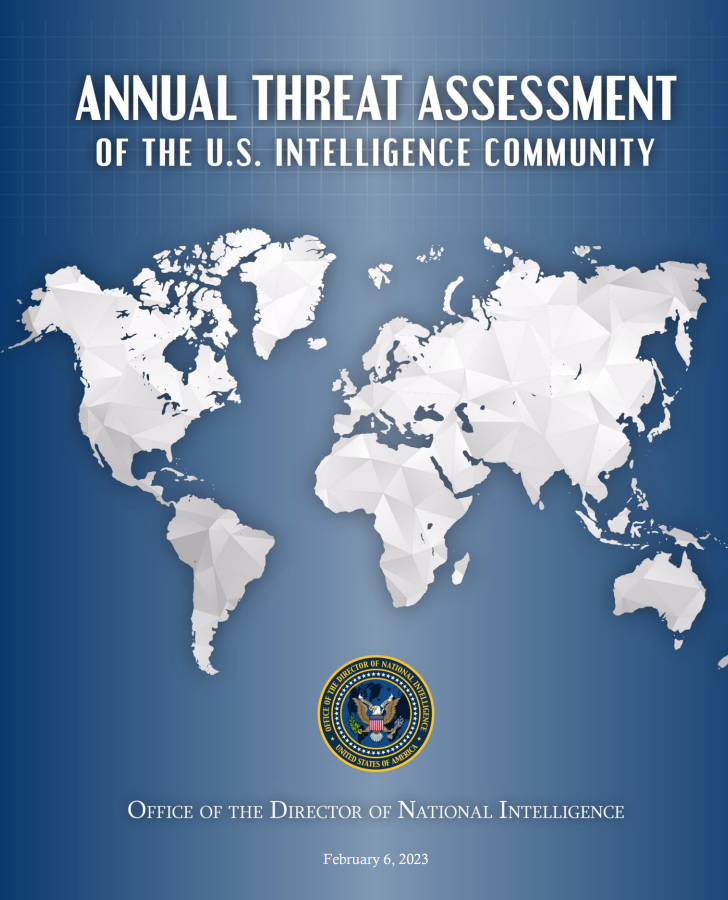
The U.S. Intelligence Community, often referred to as the I.C., submitted its 2023 Annual Threat Assessment to Congress, and its heads participated in a recent hearing. That’s an annual routine of 18 organizations in the I.C., in accordance with the Intelligence Authorization Act. Because the I.C. usually stays away from political partisanship, the report is considered to be a realistic evaluation of global threats to America. It therefore commands wide attention.
This year’s report has some notable highlights:
First, it points out that the pivotal international security environment has made it more difficult for the U.S. to ensure its own security. The report makes clear at the beginning that the U.S. is facing two intersecting strategic challenges: “[G]reat powers, rising regional powers, as well as an evolving array of non-state actors, will vie for dominance in the global order” and “[S]hared global challenges, including climate change, and human and health security, are converging as the planet emerges from the COVID-19 pandemic.”
The I.C. believes that these two challenges, which intersect and interact with each other, pose the most pressing threat to U.S. national security. This year’s assessment, dovetailing with U.S. President Joe Biden’s 2022 National Security Strategy, denotes America’ cognition of the “complexity” of the current international security environment. The U.S. wants to fight for global dominance, but it worries that a variety of shared global challenges will require it to cooperate with its rivals. Such a weighing of pros and cons will pose a challenge to its decision-making.
Second, the report places considerable value on non-traditional security challenges by rendering over half of its more than 30 pages to the assessment of a raft of non-traditional security issues, including climate change and environmental degradation, health security, developments in technology, international migration and transnational organized crime. It also mentions that the economic and political effects of the pandemic will last for several years and that climate change and ecological degradation will further fuel political unrest and humanitarian crises.
In the strategic layout of American national security — which focuses on major power competition — non-traditional security challenges remain high on the agenda, which is an objective reflection of the current international environment. However, it’s also a myth that naturally exists in America's grand strategic design, but one that is hard to overcome. The U.S. used to be a significant power in dealing with various non-traditional security challenges. Now it can barely hold the international community together to tackle a multitude of threats because it attaches more importance to major power competition. This won’t help it solve the real challenges threatening its own survival and development.
Third, the report underlines that dealing with challenges from China is America’s unparalleled priority. China-related content in this assessment is brimming with exaggerations and slanders. It lists China as the top global threat, followed by Russia, Iran and North Korea, and then elaborates on China’s regional and global objectives and activities, military capabilities, technology, economics, cyber and malign influence operations. China is increasingly challenging the U.S. economically, technologically and militarily around the world and “remains our unparalleled priority,” said Avril Haines, director of National Intelligence in the Biden administration.
While exaggerating the so-called China threat, the report also hypes the notion that domestic issues in China — such as an aging population and economic inequality — are hindering its actions. The seemingly contradictory judgments actually denote that American strategic circles have two different perceptions of China. The I.C. speculates maliciously about a crisis, or even a war, that China could cause. For example, the report has a special section called “potential interstate conflict,” claiming that tensions on the China-India border will remain strained.
As a publicly published intelligence product with influence, this annual threat assessment from the I.C. will make huge waves in Washington policy circles. It will, to a certain degree, evoke emotions and build consensus on America’s external security threats. Formulating such an assessment every year indicates in itself the deep sense of insecurity that has developed in the United States. It comes as a result of the U.S. seeking to maintain its hegemony. For a country that views itself as the most powerful in the world, harboring such a sense of insecurity is somewhat ironic. Moreover, its attempt to alleviate the sense of insecurity by squashing its rivals has actually given rise to more conflicts and greater insecurity, in addition to blocking international cooperation to fight global threats. Its strategic goals and measures proposed to achieve them are badly mismatched.
The report’s hype about a China threat will continue to promote negative perceptions about China by American society. It caters to the mentality of some special interests that stand to gain from China-U.S. competition. Federal agencies have lately been drafting 2024 budget requests and submitting them to Congress. The I.C. unveiled a budget of over $70 billion, and the Pentagon proposed a funding plan as high as $842 billion. Amid the I.C.’s constant distortions of China’s domestic and foreign policies and the hyping of the China threat theory, getting more money to maintain vested interests may also be one of its crucial purposes.
